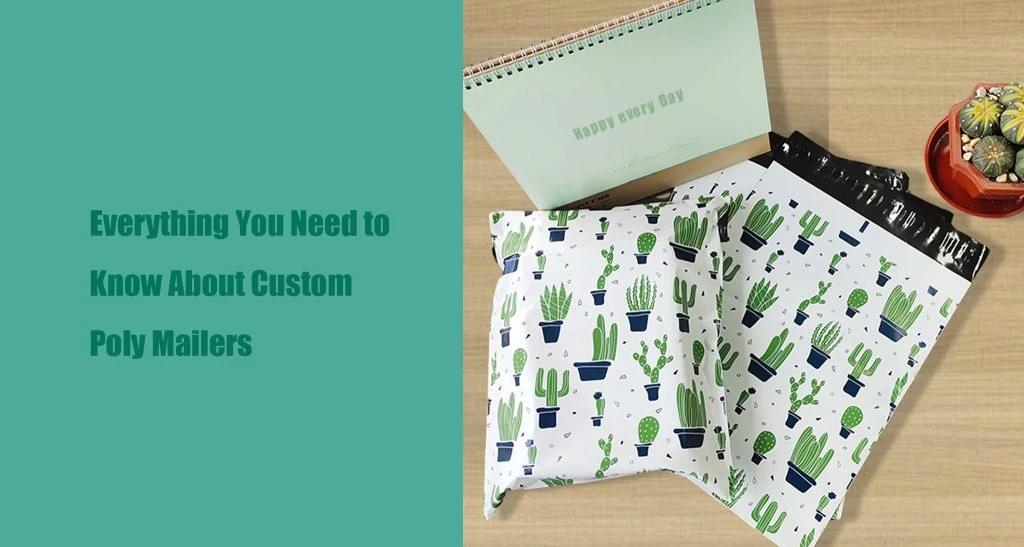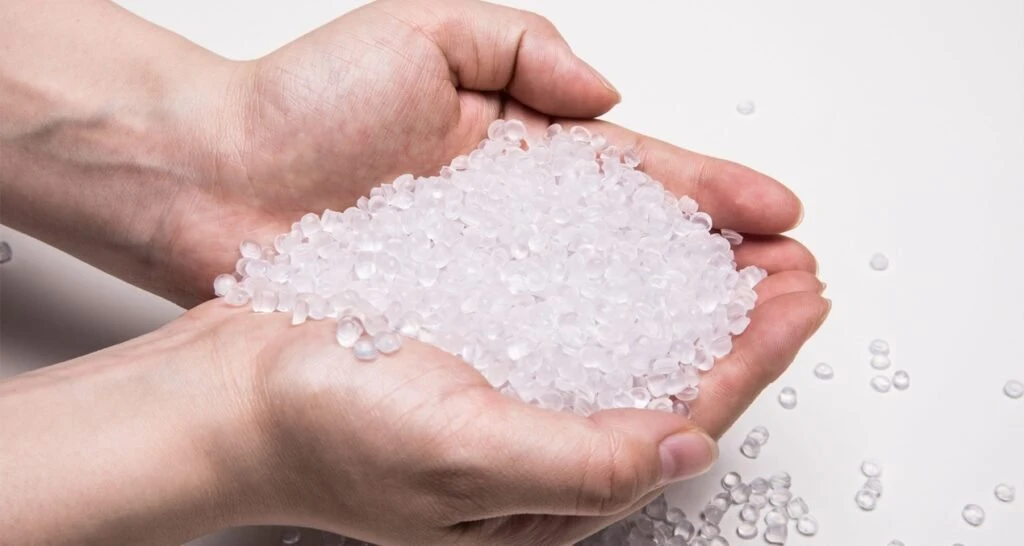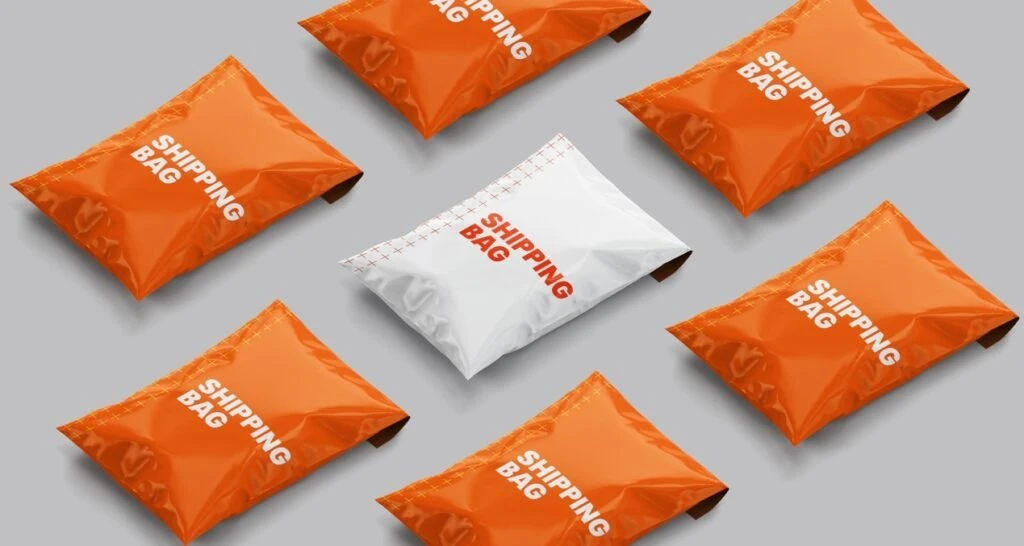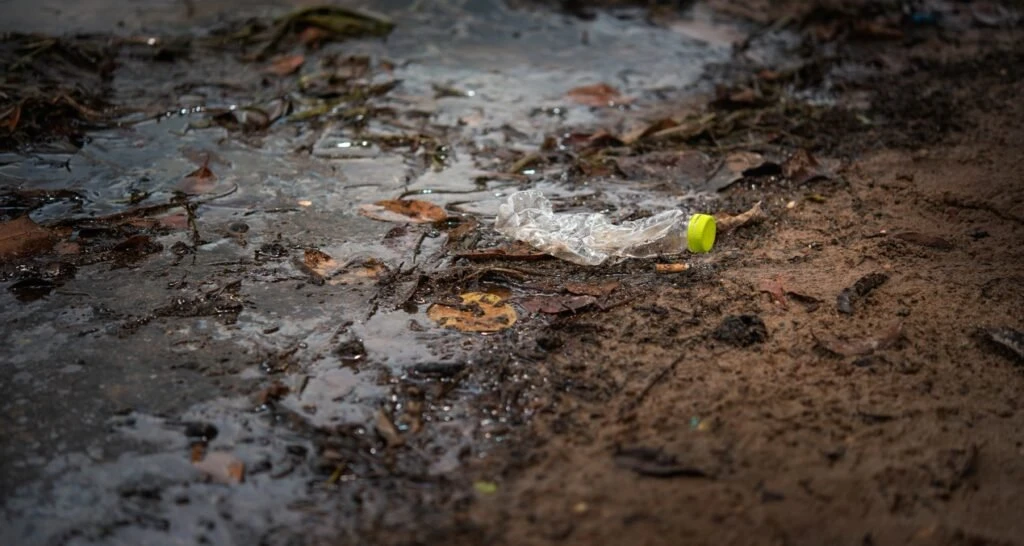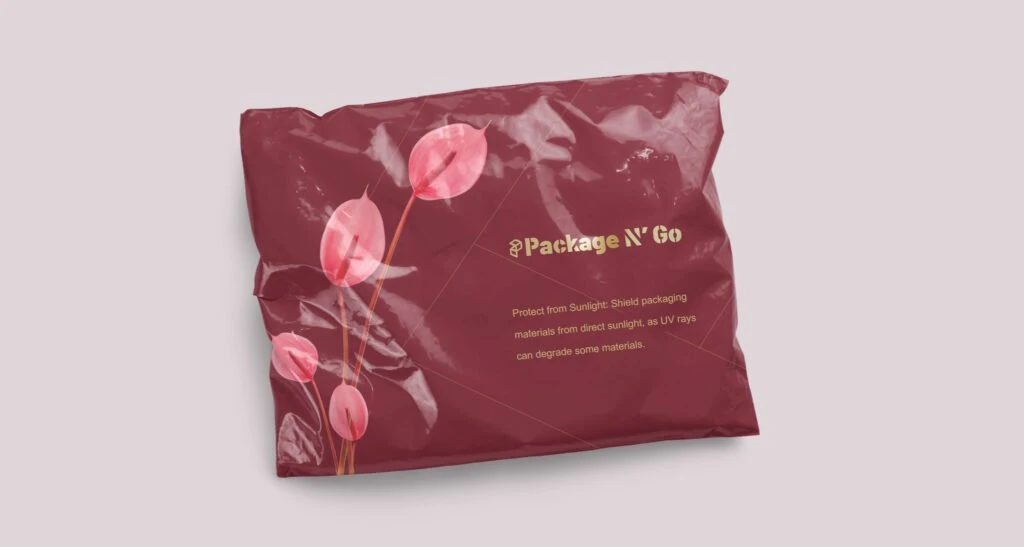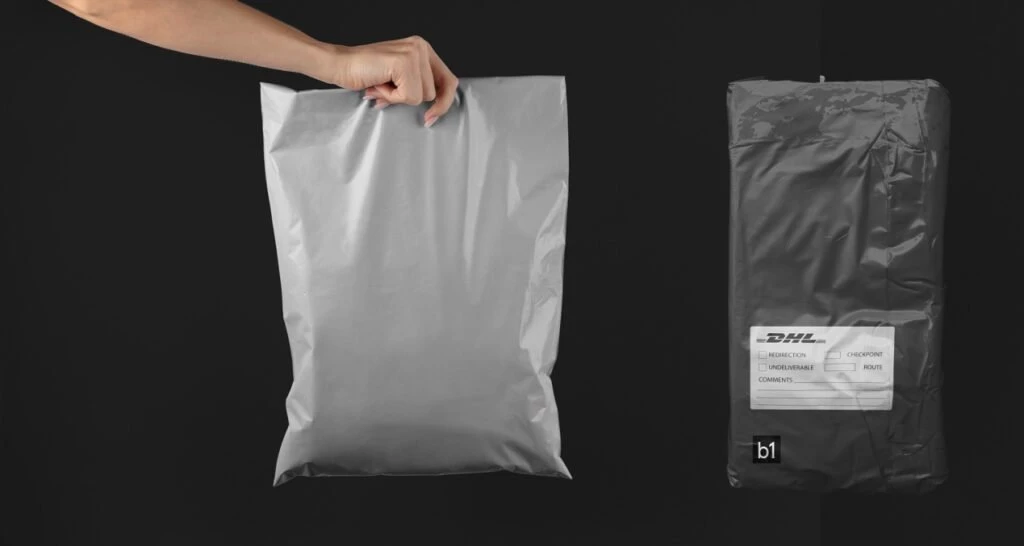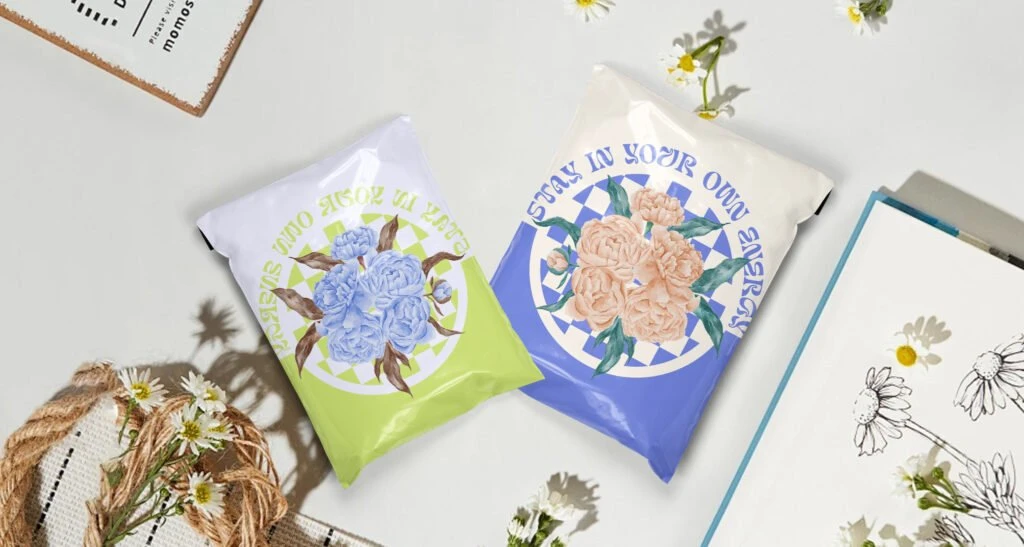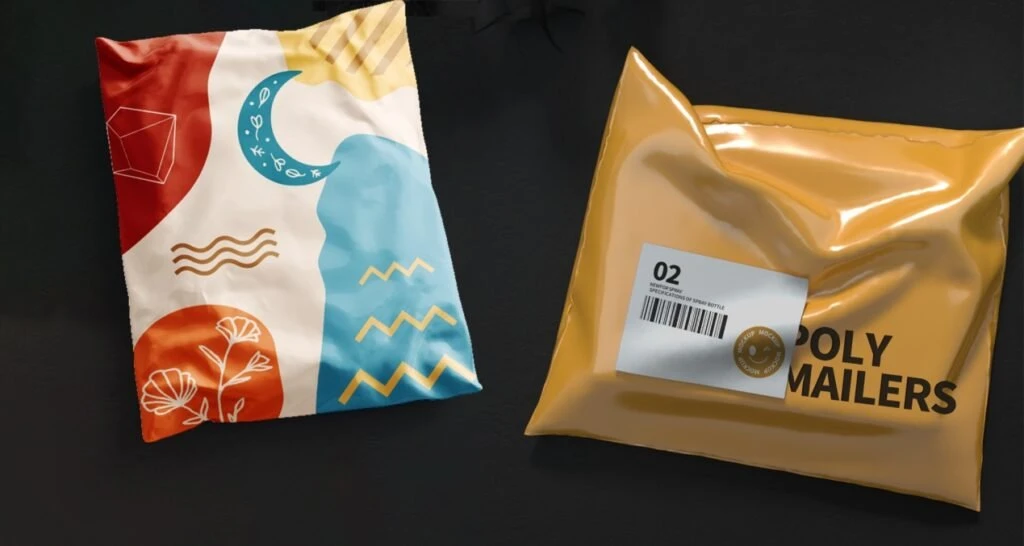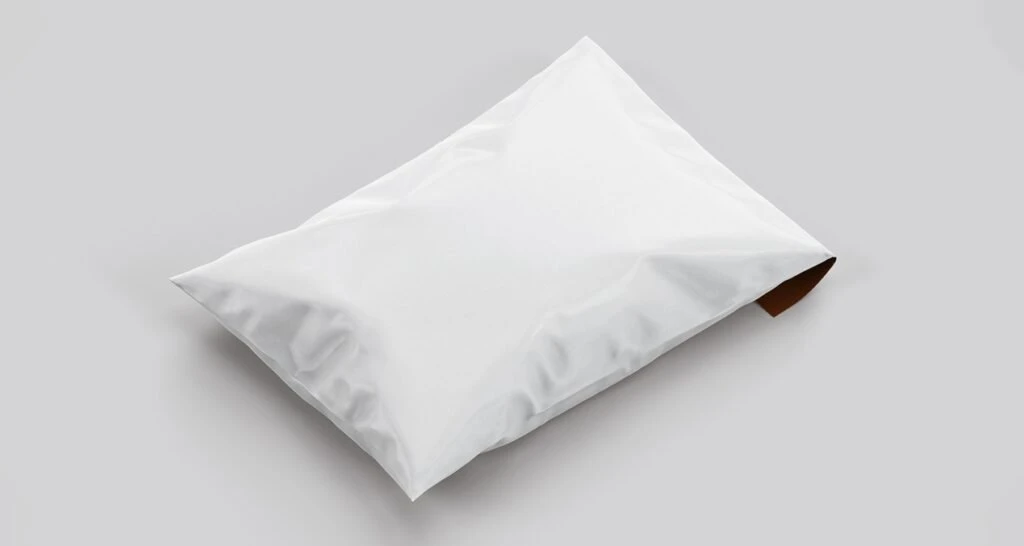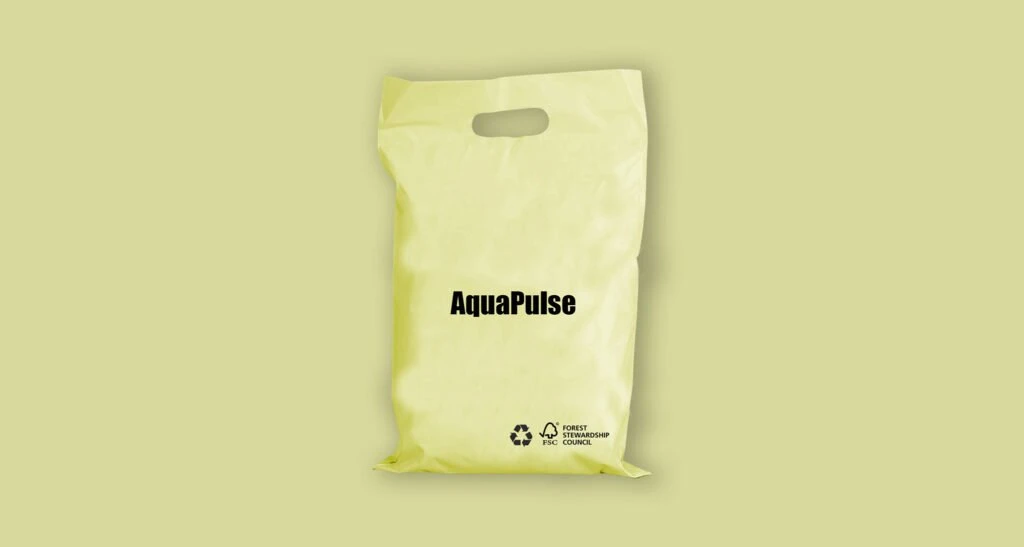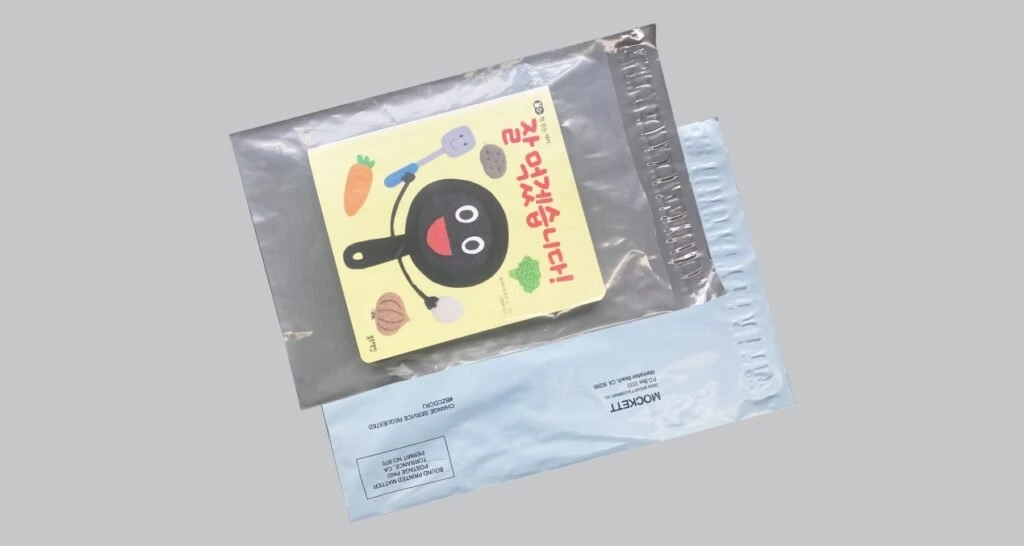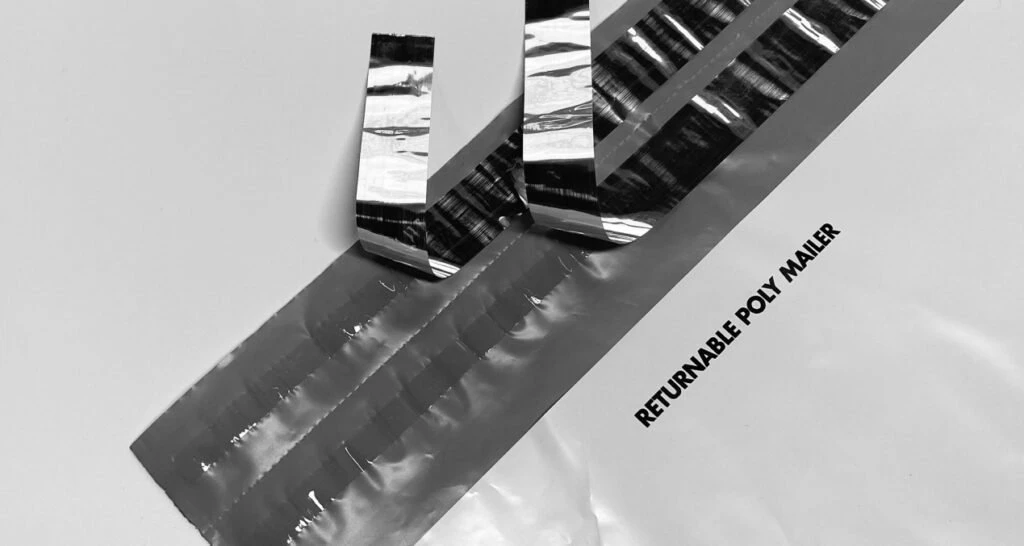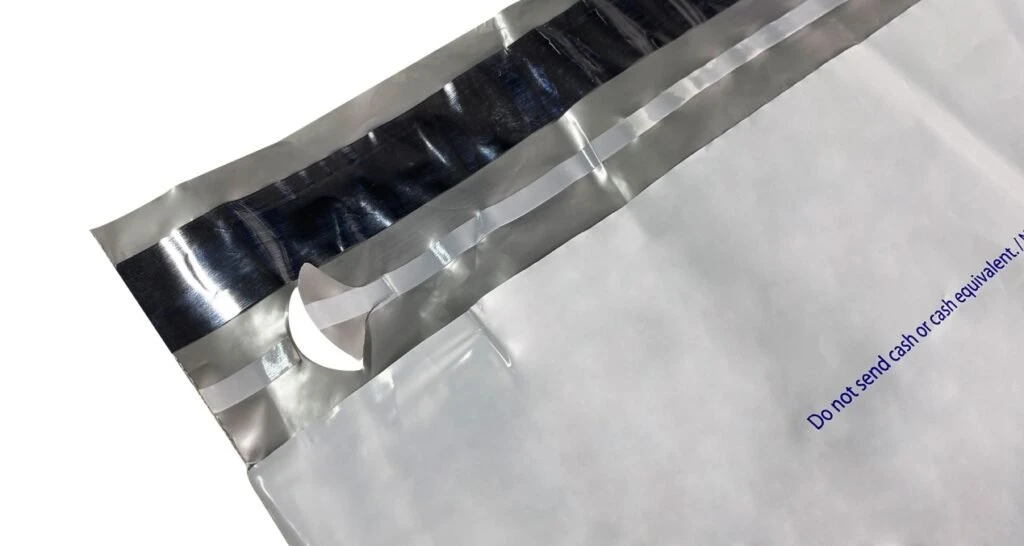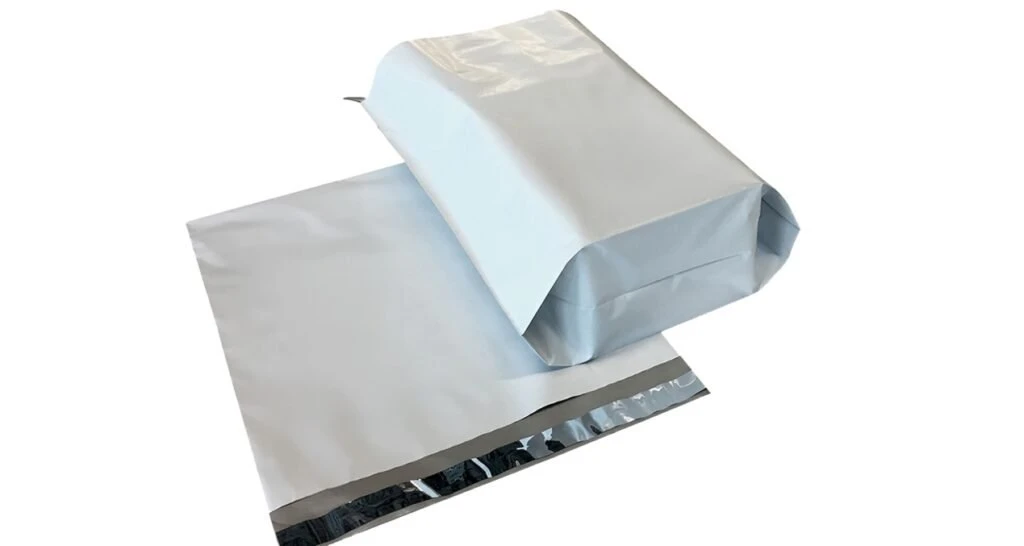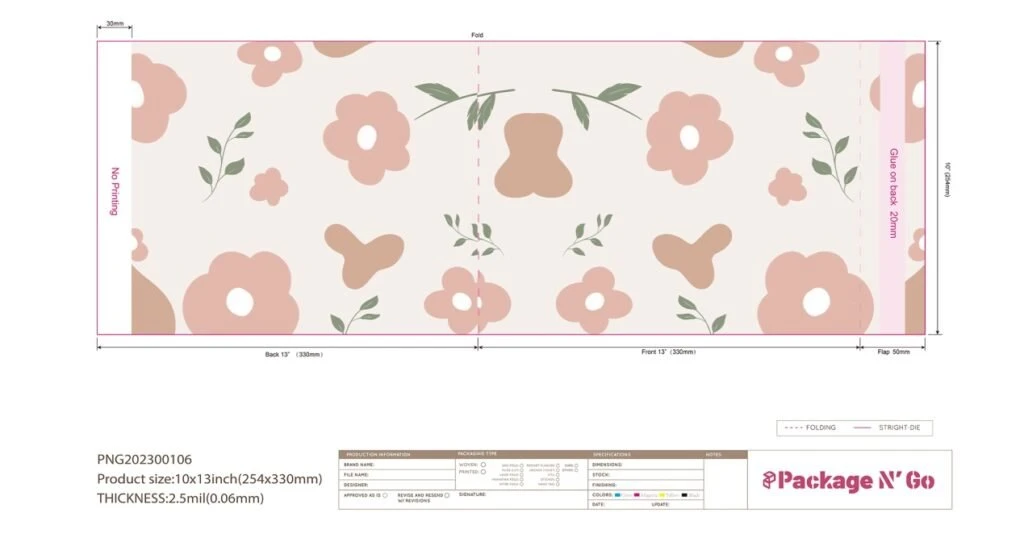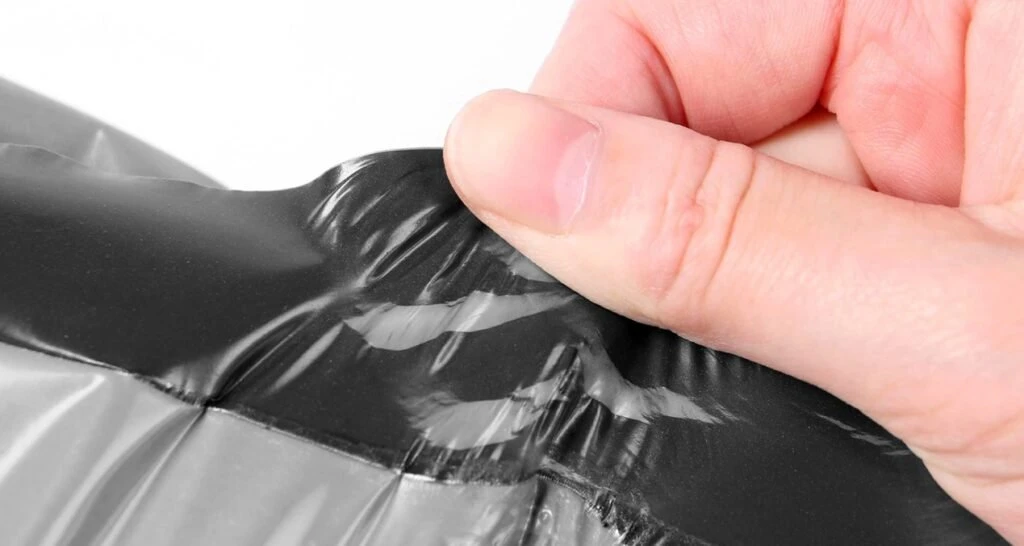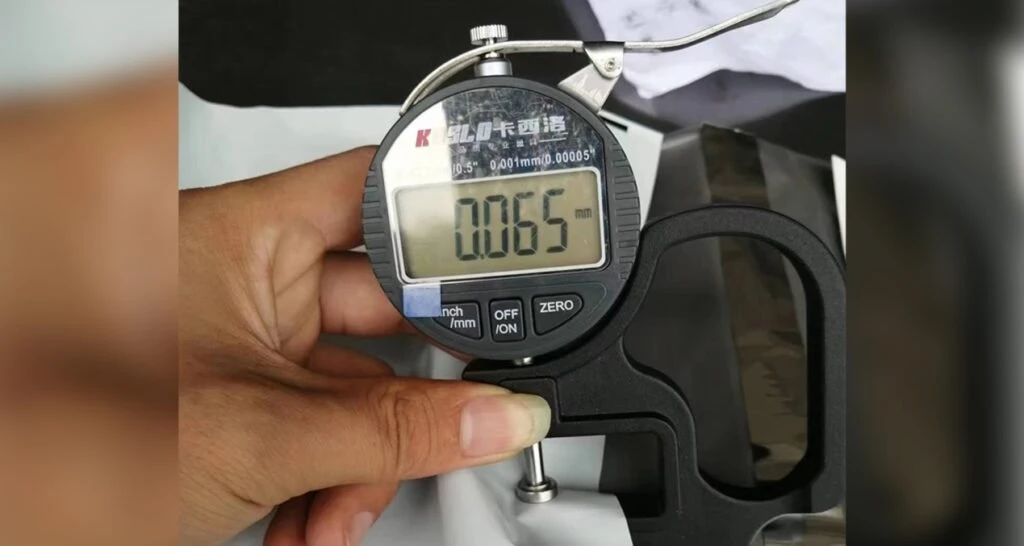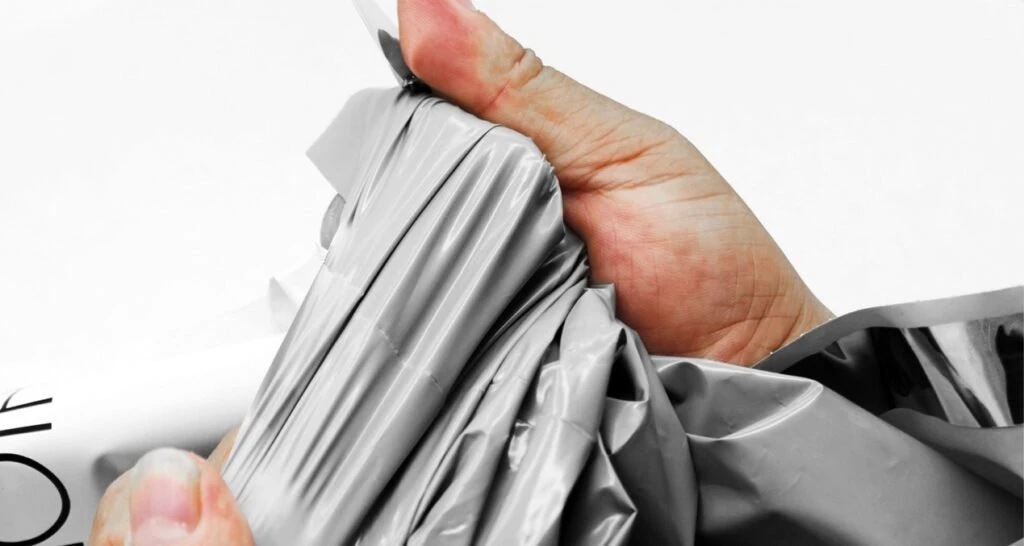Table of Contents
Chapter 1: Understanding poly mailers
1.1 What is a poly mailer?
Poly mailers, commonly known as plastic shipping bags or poly bags, are one of the most popular packing options on the market right now. They are ideal for shipping a variety of items because of their light weight, toughness, and waterproofness. Moreover, their self-sealing capability removes the requirement for additional tape during the packaging process.
The poly mailer market is anticipated to grow at a predicted pace of 4.70% from 2021 to 2028, reaching a valuation of roughly USD 1.69 billion as a result of their advantages and the expanding global e-commerce industry.
1.2 What are poly mailers made of?
Poly mailers are primarily made from chemical plastic materials such as polyethylene (PE) and polypropylene (PP). These raw materials give poly mailers good mechanical properties, heat sealing performance, and impact resistance.
Polyethylene is one of the main materials used in poly mailer production, known for its good mechanical properties and heat sealing performance. Polypropylene, on the other hand, is commonly used to produce tear-resistant poly mailers due to its high strength and impact resistance. Additionally, during the production of poly mailers, a certain proportion of plasticizers, stabilizers, fillers, and other auxiliary substances are often added to improve their performance and processability.
1.3 What items can be shipped with poly mailers?
Poly mailers are essential tools used for packaging and transporting various items, playing a crucial role in industries such as logistics, e-commerce, and everyday life. Here are some common examples of items that are shipped using poly mailers:
Logistics and shipping
Poly mailers play a key role in the logistics and shipping industry. They are used to transport and package various items such as documents, invoices, data, and goods, ensuring their safety and integrity during transit. Large poly mailers are often used to ship larger items like books, electronic products, toys, and small household items. Medium-sized poly mailers are more suitable for lightweight items such as clothing, stationery, and small toys.
E-commerce platforms
Poly mailers are commonly used packaging materials for businesses on e-commerce platforms. Whether it’s clothing, shoes, accessories, or cosmetics, they can be packaged and transported using poly mailers. This packaging method is not only convenient but also effectively protects the products, ensuring they reach consumers safely and intact.
Internal shipping and mailing
Poly mailers are also used for multifunctional shipping and mailing within enterprises. They can effectively protect goods, ensuring their safety and integrity during internal circulation processes.
1.4 What are the benefits of poly mailers?
Poly mailers have several significant advantages that make them widely used in the courier and logistics industry. Here are some key advantages:
Lightweight and easy to carry: Poly mailers are typically made from lightweight materials such as polyethylene (PE) or polypropylene (PP), making them relatively light and easy to carry and transport. This reduces transportation costs and makes it more convenient for couriers during delivery.
Waterproof and moisture resistant: Poly mailers have excellent waterproof properties, effectively protecting packages from rainwater or other liquids. This is especially important in humid or rainy environments, ensuring the safety of items inside the package.
Strong durability: Poly mailers are treated with special materials to enhance their durability. They can withstand a certain degree of pressure and friction, reducing the risk of damage and ensuring the integrity of packages during transportation.
Environmentally friendly and recyclable: With increasing environmental awareness, many poly mailers are now made from recyclable materials. This not only helps reduce waste and environmental pollution but also aligns with sustainable development principles.
Personalized customization: Poly mailers can be customized according to customer requirements, including printing company logos, contact information, and more. This helps enhance the company’s image and makes it easier for customers to access after-sales services.
Affordable price: Compared to other packaging materials such as cardboard boxes, poly mailers are often more cost-effective. This gives them a competitive advantage in terms of pricing, especially for e-commerce or logistics companies that ship a large volume of packages.
1.6 How do store poly mailers
Packaging and storage of poly mailers are crucial for ensuring the safe transportation of items and extending the lifespan of poly mailers. Here are some suggestions regarding packaging and storing poly mailers:
Packaging steps
Selecting the right poly mailer: Choose a poly mailer that suits the size, weight, and nature of the items being shipped. Ensure that the poly mailer is large enough to accommodate the items and leave enough space for sealing.
Preparing items: Organize the items to be shipped, removing excess packaging materials or attachments. For fragile or valuable items, use additional protective measures such as bubble wrap, foam boards, etc., to ensure their safety during transportation.
Placing items in the poly mailer: Gently place the prepared items into the poly mailer, being careful not to overpack or damage the items. Ensure that the items are stable inside the bag, not prone to sliding or shifting.
Sealing: Depending on the sealing method of the poly mailer, use appropriate tools or methods to seal it. For self-adhesive seal poly mailers, simply press the tape on the sealing area lightly; for poly mailers that require additional tools for sealing, use the appropriate tools to ensure a secure seal that won’t come off easily.
Storage recommendations
Avoid direct sunlight: Store poly mailers in a cool, dry, and well-ventilated place, avoiding prolonged exposure to direct sunlight. Sunlight can cause aging, discoloration, and affect the performance of poly mailer materials.
Moisture protection: Store poly mailers in an environment with relatively low humidity to prevent them from getting damp or wet. Moisture can cause mold, deformation, or reduced strength in poly mailers.
Avoid heavy pressure: When storing poly mailers, avoid placing heavy objects on top of them for extended periods. Heavy pressure can cause deformation, damage, or reduce the load-bearing capacity of poly mailers.
Categorized storage: Store poly mailers of different sizes and types separately to quickly find the required poly mailer when needed.
Following the correct packaging and storage methods ensures the effective use and extends the lifespan of poly mailers. When using poly mailers, it’s advisable to follow relevant instructions and guidelines to ensure the safe transportation of items and reduce shipping costs.
Chapter 2: Eco-friendliness of poly mailers
2.1 Influence of plastic pollution
Plastic pollution has become a critical issue for humanity. We heavily rely on plastic across various industries, leading to an alarming production rate of 400 million tonnes of plastic waste annually. This trend is alarming as plastic production has outpaced all other materials since the 1970s, with a projected 1,100 million tonnes by 2050 if not curbed.
Single-use plastic items, especially packaging, contribute significantly to this crisis, with around 85 percent ending up in landfills or as unregulated waste. Moreover, the production of these plastics relies on fossil fuels, causing a substantial 19 percent of the global carbon budget by 2040.
It is clear that urgent action is needed to address plastic pollution and its harmful consequences on the environment and human health. Thus, plastic packaging recycling has become an extremely important subject.
2.2 Are poly mailers recyclable?
Poly mailers are recyclable. They belong to recyclable products, meaning they can be regenerated in the recycling cycle.
During the recycling process, poly mailers can be processed through steps such as crushing and separating paper and plastic, to obtain clean plastic. This plastic, after being dried, can be directly pelletized and used to make various plastic products, which not only protects the environment but also maximizes the utilization of plastic waste.
However, it’s worth noting that although poly mailers can be recycled, there are still some issues in the recycling process. For example, recycling technologies may be relatively outdated, and severely damaged poly mailers may not be reusable. Additionally, lack of awareness about recycling is also a problem; many consumers may not have environmental consciousness and may dispose of poly mailers as household waste, making recycling more challenging.
Therefore, to improve the recycling rate of poly mailers, it’s necessary to not only enhance technological capabilities but also raise public awareness about environmental protection and recycling. At the same time, governments and relevant authorities should enact policies to encourage and guide more people to participate in the recycling of poly mailers.
2.3 How to recycle poly mailers?
Recycling programs and guidelines can vary significantly from one area to another. It’s essential to be aware that not all recycling centers accept poly mailers. However, there are alternative options for recycling these materials.
Many grocery stores or big-box retailers like Home Depot, Whole Foods, and Targethave have initiated recycling projects that accept plastic bags like poly mailers. They have conveniently placed drop-off bins where customers can responsibly dispose of their plastic mailers.
2.4 Recycled poly mailers
Recycled poly mailers refer to poly mailers made from recycled plastic materials. These materials are often derived from production waste or post-consumer materials, which are reprocessed to form new materials. Using recycled materials to make poly mailers has advantages such as environmental friendliness, energy conservation, sustainable utilization, cost reduction, stable quality, and wide applicability.
In the courier industry, the use of recycled poly mailers is becoming increasingly widespread. Many courier companies choose to use recycled poly mailers for packaging to save costs and achieve environmental goals. Additionally, with the increasing environmental awareness among consumers, recycled poly mailers are gaining market acceptance.
It’s important to note that the quality and performance of recycled poly mailers may be influenced by the source of the raw materials and processing techniques. Therefore, when selecting recycled poly mailers, attention should be paid to the quality control and environmental standards during the production process to ensure they meet usage requirements and environmental requirements.
Recycled poly mailers are an environmentally friendly, energy-saving, and economical packaging material with a broad application outlook. With continuous technological advancements and increasing environmental awareness, recycled poly mailers will play an increasingly important role in the courier industry.
2.5 Biodegradable and compostable options
The choice of biodegradable and compostable poly mailers mainly depends on their material. One common biodegradable poly mailer is primarily made from polylactic acid (PLA), which is derived from the roots, stems, and fruits of plants. Not only is this material abundant and renewable, but its production process is also non-polluting. Under composting conditions, this type of poly mailer can completely degrade within 180 days, achieving a full cycle in nature.
There are also poly mailers made from PBAT+PLA+starch as raw materials. This material can also undergo composting degradation under specific conditions, ultimately breaking down into carbon dioxide and water, returning to nature and aligning with advanced international concepts of reducing plastic use.
When choosing biodegradable and compostable poly mailers, it’s important to consider not only their degradation performance but also their durability, waterproofing ability, load-bearing capacity, and other practical usage needs. Additionally, ensure that the production and use of these poly mailers comply with relevant environmental regulations and standards to promote sustainable development in the courier industry.
However, despite the many advantages of these biodegradable and compostable poly mailers, it’s still necessary to choose the appropriate type based on specific circumstances in practical applications. Furthermore, to better promote environmental protection, we should raise public awareness about environmental issues and encourage more people to participate in environmental actions, contributing collectively to protecting the environment.
2.6 Certifications from authorities
As an important packaging material, poly mailers are increasingly focused on their environmental performance while ensuring the safe transportation of goods. To ensure the quality, safety, and environmental friendliness of poly mailers, they typically need to undergo certification from a series of authoritative institutions. Here are some common certifications related to poly mailers:
General Administration of Quality Supervision, Inspection and Quarantine of the People’s Republic of China (AQSIQ): An authoritative institution responsible for supervising and managing domestic product quality. AQSIQ conducts testing and certification regarding the quality and safety performance of poly mailers.
China Environmental Labeling Certification (CEC): Certifies the environmental performance of products to ensure that poly mailers meet environmental requirements during production, use, and disposal.
China Quality Certification Center (CQC): Certifies the quality of poly mailers to ensure compliance with relevant national standards and industry regulations.
International Organization for Standardization (ISO): Certifications such as ISO 9001 Quality Management System Certification and ISO 14001 Environmental Management System Certification are widely recognized international standards. They ensure that poly mailers meet international standards in production and management processes.
In addition to the certifications mentioned above, poly mailers also need to comply with specific industry standards or specifications, such as standards set by courier industry associations and national regulations related to courier packaging. These standards and specifications typically cover aspects such as size, load-bearing capacity, waterproofing performance, puncture resistance, etc., to ensure that poly mailers meet practical needs during usage.
When selecting poly mailers, consumers and businesses should pay attention to whether they have been certified by authoritative institutions and check relevant certification certificates and reports. This helps ensure the quality, safety, and environmental friendliness of the selected poly mailers and also contributes to the sustainable development of the entire courier industry.
Chapter 3: Laboratory data for poly mailers
3.1 Physical properties
The physical properties of poly mailers mainly include the following aspects:
Thickness: This refers to the thickness of the poly mailer film, which is an important indicator of its durability and quality.
Thickness deviation limit: The maximum allowable error in plastic film thickness, reflecting the level of quality control during production.
Tensile strength: The maximum initial stress observed during tensile testing, indicating the poly mailer’s resistance when subjected to external stretching forces.
Nominal strain at break: The maximum strain reached by the material before fracture, reflecting the toughness and durability of the poly mailer under tensile stress.
Tear strength at right angle: The ability of the material to resist tearing under stress, an important indicator of its tear resistance under specific loading conditions.
Heat seal strength: Used to evaluate the quality of film-to-film or film-to-other substrate heat seals, directly impacting the sealing and appearance of poly mailers to ensure goods remain undamaged during packaging, transportation, storage, and consumption.
Impact resistance: Measures the poly mailer’s resistance under impact loads, aiding in assessing its ability to withstand external impacts during transportation.
Puncture strength: Measures the material’s ability to withstand puncture forces under certain conditions, crucial for preventing sharp objects from piercing the poly mailer and causing damage to internal items.
Testing these physical properties is crucial to ensuring the quality, safety, and reliability of poly mailers. When selecting poly mailers, consumers and businesses should pay attention to these performance indicators to ensure that the chosen products meet practical needs and safeguard the safety of goods during transportation.
3.2 Chemical properties
The chemical properties of poly mailers primarily involve material stability, corrosion resistance, and potential toxicity. Since poly mailers are typically made of plastic materials like polyethylene (PE) or polypropylene (PP), these materials may be affected by chemical factors during manufacturing and use.
Firstly, chemical stability refers to the degree to which poly mailers can maintain stable structure and performance when in contact with different chemicals. High-quality poly mailers should have good chemical stability, maintaining their original physical properties and appearance in various environments.
Secondly, corrosion resistance refers to the poly mailer’s resistance to corrosive substances such as acids and alkalis. Some high-quality poly mailer materials exhibit good corrosion resistance, able to resist erosion from corrosive substances to some extent, thereby extending their lifespan.
However, it is important to note that some poly mailers may contain a certain amount of harmful substances due to the use of recycled materials or the addition of certain additives during production. These harmful substances may pose potential threats to human health, such as allergies, skin inflammation, etc. Therefore, when choosing poly mailers, consumers and businesses should pay attention to their chemical properties and select products that comply with national standards and environmental requirements.
Additionally, to safeguard consumer rights, it is recommended to inspect the appearance and quality of poly mailers when using them. If any abnormalities such as unusual odors or colors are detected, consumers should promptly contact the seller or relevant authorities for handling. Furthermore, in cases where health issues or allergies arise due to poly mailer quality problems, consumers can seek compensation from the seller and seek legal assistance.
The chemical properties of poly mailers are an important indicator for evaluating their quality and safety. When selecting and using poly mailers, attention should be given to their chemical stability, corrosion resistance, and potential toxicity, choosing products that meet standards and environmental requirements.
Chapter 4: How much are poly mailers?
4.1 Prices of custom poly mailers
The price of poly mailers varies depending on factors such as material, size, thickness, weight capacity, waterproof performance, and brand. Generally, high-quality poly mailers tend to have a higher price, while standard ones are more affordable. Additionally, prices may differ between regions.
Furthermore, the quantity purchased also affects the unit price of poly mailers. Typically, buying in bulk can lead to more favorable prices. Therefore, if you need to purchase a large quantity of poly mailers, it’s advisable to negotiate with the supplier to obtain a better price.
When choosing poly mailers, besides considering the price, it’s essential to assess their quality and environmental performance. High-quality poly mailers not only have good physical and chemical properties to protect goods during transportation but also meet environmental standards, being eco-friendly.
Hence, when selecting poly mailers, it’s recommended to consider factors such as price, quality, environmental performance, and supplier services to choose the product that best fits your needs. Additionally, keep an eye on market price fluctuations and promotional activities to get better prices.
Please note that due to market fluctuations and uncertainties, I cannot provide specific prices for poly mailers. You can consult local suppliers, check relevant websites, or conduct market research to obtain more accurate price information.
4.2 Factors that influence prices
The price of poly mailers is influenced by several factors, including the following:
Material and quality: The material of poly mailers is a key factor in determining the price. Different materials have varying costs and performance characteristics. For example, polyethylene (PE) bags are generally priced slightly lower than polypropylene (PP) bags, while polyester (PET) bags typically have a higher price tag. Additionally, the quality and thickness of the bags also impact the price, with higher-quality and thicker bags usually commanding a higher price.
Size and customization requirements: The size and customization requirements of poly mailers also affect the price. Larger-sized bags typically require more materials and processing, hence they are priced higher. If there are specific customization needs such as special designs, colors, printing patterns, or logos, these additional customization requirements can also increase the cost and price.
Raw material costs: The main raw material for poly mailers is plastic pellets. The cost of these materials fluctuates based on market prices and production demands. Typically, the price per ton of plastic pellets fluctuates within a certain price range.
Quantity: The quantity of the order is also a significant factor influencing the price.
In addition to these primary factors, market supply and demand for poly mailers, regional price levels in production areas, and pricing strategies of suppliers also play a role in determining the price.
Chapter 5: How to customize your poly mailers?
Customizing your poly mailers to precisely match your unique marketing and shipping demands involves crucial decision-making on various aspects, such as types, materials, sizes, thicknesses, and designs.
5.1 Different types of poly mailers
Poly mailer bags come in various types based on their structure and features:
Regular self-sealing poly mailers
The standard option with no special features, suitable for general shipping needs.
Poly mailers with handles
These have die-cut handles on top for easy carrying and create a higher-grade impression on customers.
Clear-view poly mailers
Made with a transparent film on one side, allowing customers to view the contents of the package.
Wicket poly mailers
Ideal for companies with large shipment volumes, as they simplify the packaging process with tear-down function.
Returnable poly mailers
Feature double self-sealing strips, allowing the bag to be reused for future shipments, reducing plastic waste.
Poly mailers with tear strips
Have a perforated tear-off strip for easy opening.
Gusseted poly mailers
Designed with bottom and side gussets to increase loading capacity and provide extra protection for bulkier items.
5.2 What design files should be provided?
The design document for poly mailers should include the following key elements to ensure they meet usage requirements and comply with relevant standards:
Specification dimensions: Clearly define the precise dimensions of the poly mailers, including length, width, and thickness. This helps ensure that the packaging can fully accommodate the items to be shipped and prevents damage or spillage during transportation.
Material description: Provide detailed information about the manufacturing materials of the poly mailers, such as polyethylene (PE), polypropylene (PP), etc., and their physical and chemical properties. This ensures that the poly mailers can withstand adverse environmental conditions during transportation, such as friction, impact, and corrosion.
Structural design: Include the overall structural design and detailed design of the poly mailers, such as the sealing method of the bag opening and the load-bearing structure at the bottom. The design should consider usability, safety, and durability to facilitate packaging, transportation, and unpacking processes.
Printing requirements: If there is a need to print company logos, contact information, or promotional messages on the poly mailers, provide detailed printing requirements, including printing position, colors, font, and size. This ensures clear and aesthetically pleasing printing that aligns with brand image and promotional needs.
Environmental standards: Specify the environmental standards that the poly mailers comply with, such as biodegradability, recyclability, etc. This helps minimize environmental impact during their use, aligning with sustainability requirements.
Safety standards: The design of poly mailers should adhere to relevant safety standards, such as being non-toxic, odorless, non-irritating, etc. Additionally, consider extreme conditions the poly mailers may encounter during transportation, such as high or low temperatures, to ensure they maintain good performance under these conditions.
The design document for poly mailers should comprehensively and detailedly describe their specification dimensions, material description, structural design, printing requirements, environmental standards, and safety standards to ensure they meet various requirements and comply with relevant standards during use.
5.3 Tips for designing custom poly mailers
When designing poly mailers, several aspects need to be considered to ensure their functionality, practicality, and environmental friendliness. Here are some suggestions for designing courier bags:
Size and weight capacity
Design appropriate dimensions and weight capacity based on the size and weight of the items to be shipped, ensuring that the poly mailer can safely accommodate and transport the items.
Consider reinforced designs such as thickened bottoms or adding support structures to improve the weight capacity and durability of the poly mailer.
Material selection
Choose durable and environmentally friendly materials, such as recyclable polyethylene (PE) or polypropylene (PP).
Consider using materials with good toughness and abrasion resistance to increase the poly mailer’s lifespan.
Easy open and seal design
Design an easy-to-open sealing method, such as heat-sealed strips or self-adhesive strips, to allow users to quickly open the poly mailer.
Ensure that the seal is secure to prevent items from falling out or leaking during transportation.
Labeling and printing
Design clear and prominent labels and printing content, including company name, contact information, address, etc., to enhance brand awareness and facilitate user contact.
Use environmentally friendly ink for printing to reduce environmental impact.
Visual window
Consider designing a visual window on the poly mailer, allowing users to directly see the contents inside, increasing trust and transparency.
Handles and straps
Add comfortable handles or straps to facilitate users in carrying and moving the poly mailer.
Ensure that handles or straps are sturdy and durable enough to withstand a certain weight.
Environmental considerations
Use biodegradable or recyclable materials to reduce environmental pollution.
Consider designing poly mailers that can be reused, reducing waste and garbage generation.
Safety
Ensure that the poly mailer’s seal and edges are smooth and free of sharp parts to prevent user injuries during use.
Consider adding anti-counterfeiting labels or security measures to improve the poly mailer’s safety.
Designing poly mailers should focus on aspects such as size, weight capacity, material selection, easy-open and seal design, labeling and printing, visual window, handles and straps, as well as environmental and safety considerations. By comprehensively considering these factors, you can design poly mailers that are both practical and environmentally friendly, meeting market demands and user expectations.
Chapter 6: How are poly mailers made?
6.1 Production process
The production process of poly mailers mainly includes the following key steps:
Material preparation: Select suitable plastic materials as raw materials, typically using polyethylene (PE) or polypropylene (PP). These materials are carefully chosen to ensure their quality and stability meet production requirements.
Mixing: Thoroughly mix the required raw materials using a mixing machine according to a specific formula. This process ensures the uniformity and consistency of the raw materials, laying a solid foundation for subsequent production processes.
Film blowing: Use a film blowing machine to heat and melt the mixed materials and blow them into thin films. During this step, machine parameters need to be carefully adjusted to ensure that the film’s thickness, size, and color meet production requirements.
Bag making and die cutting: Cut the blown films into the desired shapes and sizes according to the poly mailer’s size requirements using a die-cutting machine.
Printing: Print on the cut films based on customer requirements. Printing techniques can include flexographic printing, gravure printing, etc., to achieve exquisite printing of logos, text, patterns, etc.
Heat sealing and bag making: Use a heat sealing machine to close and seal the cut films, forming complete poly mailers. This step requires a reliable heat seal to ensure that the poly mailers are not easily opened or leak during use.
Inspection and packaging: Conduct quality inspection on the produced poly mailers to ensure there are no damages or other quality issues. Qualified poly mailers are then packaged and bundled for convenient transportation and storage.
Throughout the production process, it’s crucial to strictly adhere to relevant technical requirements and standards to ensure the quality, environmental performance, and safety of poly mailers. Additionally, continuous optimization of production processes and technologies is necessary based on market demand and customer feedback to improve the performance and competitiveness of poly mailers.
Please note that the production process may vary slightly among different poly mailer manufacturers or even within the same manufacturer’s different equipment. Therefore, the specific production process needs to be adjusted and improved according to actual circumstances.
6.2 Production lead time
The length of the production lead time is influenced by various factors, including production scale, equipment capabilities, process complexity, raw material supply, optimization of production processes, and order volume.
For small orders, we generally have a minimum order quantity of 10,000 pieces. If printing is required, plate-making takes 4-6 days, and the total production lead time is around 15 days.
For large-scale customized production of poly mailers, we flexibly adjust based on market demand and order volume to meet customers’ timely needs.
For specific production lead time, we suggest customers directly contact us, and we can provide accurate production lead time information based on your specific requirements and order scale. Additionally, you can also refer to the average production lead time in the industry, but please note that this is only a rough reference range, and specific situations need to be confirmed based on actual conditions.
Chapter 7: How to do the quality inspection for poly mailers?
During and after the production process, quality control measures are meticulously incorporated into every session.
7.1 Why is quality inspection important?
The importance of quality inspection for poly mailers is based on several key reasons:
Protection of shipped items: Poly mailers serve as packaging materials for shipping items and directly protect the contents. If the quality of poly mailers is subpar, such as incorrect dimensions, inadequate thickness and strength, or poor puncture resistance, it can lead to damage during transportation. This not only affects the consumer experience but can also result in reputational and financial losses for businesses. Therefore, quality inspection ensures that poly mailers meet relevant standards, ensuring the safety of shipped items during transportation.
Industry development: Quality inspection of poly mailers contributes to the healthy development of the industry. Establishing and enforcing uniform testing standards effectively supervises and manages the production and quality of poly mailers. This not only enhances the industry’s image but also drives it towards more standardized and positive development.
Competitiveness: Poly mailers that meet quality inspection standards are more competitive. In a competitive market, high-quality products often attract more consumers. Therefore, prioritizing quality inspection and continuously improving the quality of poly mailers is crucial for businesses to stand out in the market.
Environmental considerations: Quality inspection of poly mailers is also essential from an environmental perspective. For example, inspecting whether the materials of poly mailers are non-toxic, odorless, comply with relevant national hygiene standards, and meet environmental requirements during production are critical steps to ensure that poly mailers are environmentally friendly.
Quality inspection of poly mailers plays a vital role in ensuring the safety of shipped items, promoting industry development, enhancing product competitiveness, and protecting the environment. Therefore, both manufacturers and consumers should give full attention to and actively participate in quality inspection of poly mailers.
7.2 How many samples will be inspected?
The number of samples to be checked for poly mailers depends on the specific testing items and sampling methods.
Generally, the sampling quantity for each product varies depending on different inspection items. For example, the sampling quantity for shopping bags directly in contact with food may include 100 samples, with 60 samples for inspection (40 for physical performance and 20 for hygiene performance), and the remaining 40 samples as backup samples. For shopping bags not directly in contact with food, the sampling quantity may be 80 samples, with 50 samples for inspection and 30 samples as backup samples.
In practical operations, the sampling quantity may be adjusted based on the company’s specific regulations, testing needs, and product quality control requirements. Therefore, the specific number of samples should be determined according to the company’s sampling method and relevant regulations.
Furthermore, to ensure the fairness and representativeness of sampling, random numbers are typically generated using methods such as random number tables, random number dice, or playing cards. These random numbers are then used to select samples for inspection.
7.3 Quality inspection criteria
The quality inspection standards for poly mailers mainly cover the following aspects:
Appearance quality inspection:
- Color and transparency: Ensure that the color of the poly mailer is uniform without significant color deviation, and the transparency meets requirements without cloudiness.
- Printing quality: Check if the printed patterns are clear, accurate, free from significant color deviation and misspelled words, ensuring compliance with design requirements.
Physical performance testing:
- Tensile strength: Test the sample’s tensile strength to evaluate its ability to withstand stretching during use.
- Tear strength: Assess the poly mailer’s resistance to tearing by testing its tear strength.
- Puncture resistance: Check the poly mailer’s resistance to punctures to ensure it does not easily tear or puncture during transportation.
Size and thickness testing:
- Size: Ensure that the poly mailer’s dimensions meet specified requirements, such as length, width, etc., to accommodate various packaging needs.
- Thickness: Check if the poly mailer’s thickness is sufficient to prevent tearing or rupturing during transportation.
Chemical composition testing:
- Material: Verify if the poly mailer’s material is non-toxic, odorless, and complies with relevant national health standards.
- Hazardous substances: Test for the presence of harmful substances like heavy metals, volatile organic compounds (VOCs), etc., ensuring compliance with environmental protection requirements.
Hygiene and safety testing:
- Pollution-free production: Check if the raw materials and production processes for poly mailers are pollution-free and meet environmental protection requirements.
- Biodegradation rate: Evaluate the biodegradation rate of the plastic packaging used in poly mailers to assess their environmental performance.
Other Indicators:
- Waterproof performance: Ensure that the poly mailer does not leak water under certain pressure, maintaining the dryness of the contents.
- Weather resistance: Evaluate the poly mailer’s oxidation index to assess its oxidation stability and weather resistance.
The quality inspection standards for poly mailers constitute a comprehensive evaluation system covering appearance, physical performance, size, chemical composition, hygiene and safety, and other aspects. Strict adherence to these standards helps ensure the reliable quality of poly mailers, meeting market demands and consumer expectations.
7.4 Who does the quality inspection for you?
Quality inspection of poly mailers is typically conducted by professional quality testing organizations or third-party certification bodies. These organizations have the relevant testing qualifications and technical capabilities to conduct comprehensive and objective quality inspections of poly mailers according to relevant standards and regulations.
Quality testing organizations evaluate poly mailers based on aspects such as production processes, raw materials, and performance characteristics. They conduct tests and assessments on multiple indicators of poly mailers, including appearance, dimensions, physical performance, chemical composition, hygiene and safety, to ensure compliance with relevant standards and requirements.
Third-party certification bodies certify and audit poly mailers to ensure they meet specific quality standards or industry standards. These bodies conduct comprehensive reviews of the production process, quality management system, and issue corresponding certification certificates to demonstrate the quality and compliance of poly mailers.
For businesses, it is crucial to choose authoritative and credible quality testing organizations or third-party certification bodies for quality inspection of poly mailers. This not only ensures that the quality of poly mailers meets market and consumer demands but also enhances the competitiveness and credibility of the enterprise.
It’s important to note that different countries and regions may have different quality standards and testing requirements for poly mailers. Therefore, businesses should ensure they choose organizations that comply with local standards and requirements when selecting quality testing organizations or third-party certification bodies to ensure the quality and compliance of poly mailers.
Quality inspection of poly mailers should be conducted by professional quality testing organizations or third-party certification bodies to ensure they comply with relevant standards and requirements, safeguarding consumer and market interests.
7.5 Common issues and solutions for poly mailer products
Poly mailer products may encounter a range of issues during production and use, which can involve aspects such as manufacturing processes, material quality, and environmental conditions. Here are some common problems and their corresponding solutions:
Common issues
Insufficient thickness: Customers report that the bags are thinner than before or not thick enough. This could be due to slight variations between production batches or imprecise control in the manufacturing process.
Bursting or rupturing of bags: This may occur due to excessive cutting speed, manufacturing process issues, or problems with material quality.
Adhesive issues: Bags sticking together due to excessive adhesive or not sticking properly due to insufficient adhesive can be attributed to manufacturing process issues.
Size discrepancies or uneven thickness: This could result from poor control during film blowing in the factory or improper machine adjustments.
Packaging deficiencies leading to product damage: Insufficient packaging strength or problems with packaging materials or methods can result in product damage.
Solutions
Strengthen manufacturing process control: For issues like insufficient thickness, bursting or rupturing, adhesive problems, etc., optimizing the manufacturing process and strictly controlling production parameters such as cutting speed and temperature can ensure stable product quality.
Rigorous control of material quality: Choosing high-quality materials and ensuring their stability can reduce quality issues caused by material problems.
Improve packaging design: To address packaging deficiencies causing product damage, optimizing packaging design to better suit the product’s characteristics can enhance packaging strength and protective effects.
Establish quality inspection System: Implementing a comprehensive quality inspection system to rigorously monitor various aspects of the production process ensures product quality meets relevant standards and requirements.
Enhance employee training and management: Improving employees’ quality awareness and operational skills ensures they follow standards and requirements, reducing quality issues due to human factors.
Resolving common issues with poly mailer products requires considering multiple factors such as manufacturing processes, raw materials, packaging design, quality inspection, etc. By implementing comprehensive strategies, product quality and customer satisfaction can be improved.
Chapter 8: Development trends
The development history of poly mailers is closely related to their future development direction, reflecting the combined drive of market demand, technological advancement, and environmental awareness. From simple packaging materials in the beginning to multifunctional products evolving towards eco-friendliness, intelligence, and aesthetics, the evolution of poly mailers demonstrates the mutual push of market demand, technological progress, and environmental consciousness.
In recent years, with the rapid rise of the e-commerce industry, the volume of courier services has continued to grow, leading to the rapid development of the poly mailer market. As a core packaging material for courier services, the demand for poly mailers has been steadily increasing. This growth trend is expected to continue in the coming years, providing ample development opportunities for the poly mailer market.
The development history of poly mailers reflects the combined push of market demand, technological progress, and environmental awareness. In future development, poly mailers will place more emphasis on eco-friendliness, intelligence, and aesthetics, aiming to achieve green and smart development goals.
Furthermore, with the increase in environmental awareness, more and more poly mailers are adopting green and eco-friendly materials. For example, some poly mailers are made from biodegradable materials, exhibiting excellent biodegradability to reduce environmental pollution.
In addition to environmental performance, poly mailers have also made progress in intelligence. The application of intelligent packaging materials has endowed poly mailers with more functions, such as tracking and information recognition. These functions enhance delivery efficiency and provide consumers with a more convenient and efficient shopping experience. Additionally, attractive packaging designs have become an important direction for poly mailer development, enhancing brand image, attracting consumers’ attention, and adding value to products.
The development of the poly mailer industry still faces challenges. Balancing environmental protection with costs and promoting the green transformation of the entire industry are urgent issues to address. Governments, businesses, and society as a whole need to work together to formulate relevant policies and standards, promoting the sustainable development of the poly mailer industry.
As a critical element of the modern courier industry, poly mailers bear the mission of safely transporting goods while facing challenges in environmental protection and intelligence. In future development, poly mailers will continue to evolve towards eco-friendliness, intelligence, and aesthetics, contributing to the sustainable development of the courier industry. At the same time, we need to realize that the development of the poly mailer industry is a systematic project requiring the collective efforts of governments, businesses, and society to promote the green transformation and sustainable development of the poly mailer industry.
Chapter 9: Conclusion
The widespread use of poly mailers benefits from the rapid growth of the e-commerce industry. With the popularity of online shopping, the volume of courier services has surged, leading to an increase in demand for poly mailers. They fulfill the crucial role of safely transporting goods, ensuring the integrity and security of products during transit. Whether for food items, clothing, or electronics, poly mailers offer suitable packaging solutions to meet various shipping needs.
As a leading manufacturer of custom packaging, we specialize in creating unique solutions tailored just for you. Reach out today to start your packaging journey!


